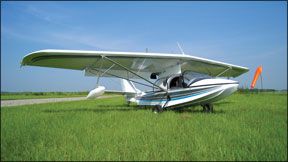Amphibious LSAs are like a cold ice cream cone on a hot summer day: Nobody really needs one, but once you’ve had a taste, you really, really want one.
But practicality is a matter of perspective. Having the option to drop in on a lake or river and pull up to the local fish shack for lunch makes for some serious recreation. Having the option to use most any airport for, hangaring, refueling or maintenance is seriously convenient.
You’ll pay for that flexibility with a slower cruise and some added complexity of retractable gear. Hey, you can’t have everything.
Looks Can Deceive
Kerry Richter, president of Progressive Aerodyne, started building hang gliders in high school and was working on ultralights by the late 70s. The first Searey (known as the A model) was available as a kit in 1992, with the B and C models following in 1996 and 2002. The latest model is the Searey LSX / Sport. The LSX is the kit version. The Sport is a ready-to-fly S-LSA.
The Searey still looks a bit like an ultralight, in our opinion. This image is dispelled once you get your hands on the aircraft. Aileron, elevator and flap controls are all pushrod and torque tube. Many of the connections are exposed for easy preflight. The wing is cloth over aluminum for weight savings, and ease of detailed inspection and repair should you run it into a dock piling. Other nice pluses are standard LED lights and an electric bilge pump. We liked the heavy switches and clean panel layout. It even has cabin heat, despite the distance to the engine.
The gear look spindly, but the system is beefy and feels solid in taxi and landing. Extension is electric with no emergency system. If they don’t come down, land on the water or some grass. Braking is via a single control on the throttle—not our favorite system. On the plus side, the tailwheel is steerable and the rudder is effective at anything above a crawl due to the thrust from the pusher prop. Primary controls are via a stick for each seat. There’s no parking brake, which we found a miss especially since you must step on the wheel to hike a leg over the nose-high sill when you’re getting into the aircraft on the ground. We’d like to see a step and/or a way to lock that wheel.
The seats are comfortable, but not adjustable. The rudder pedals do adjust. The cabin is 44 inches wide and we’ll laid out for controls. The only exception might be the flap handle, which pulls down from above, between the seats. Once you can grab it without looking, it shouldn’t be a problem. Visibility over the nose is acceptable for land taxi and takeoff, and excellent for landing and all water operations. The canopy that slides back separately on each side is terrific: Slide it back to enjoy the air rolling by in flight, and slide it forward to stay dry on those water landings.
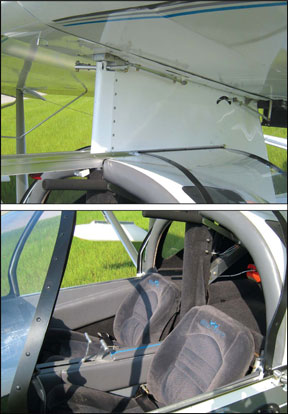
The only baggage area is on a shelf behind the seats and holds 60 pounds. We’d like to see a cargo net for safety or a storage compartment (there is an optional one for the kit version only). The aircraft is heavy for an LSA—about 940 pounds empty—but amphib LSAs have a gross weight limit of 1440 pounds, so it still has a respectable useful load.
Fabulous Flier
The Searey is a joy in the air and on the water. Refinements to the LSX/Sport included wing and trim refinements and it shows. Slow flight was controllable below 40 knots indicated and stalls were a non-event. In fact, it was hard to get anything resembling a real stall when power-on. Stick forces are close to what you’d expect in a two-seat, certified airplane. Nearly all LSAs are too light in pitch, but the Searey is better than most we’ve flown.
Overall stability was good, however, the pylon-mounting of the engine means the aircraft will change pitch noticeably when power is added or removed. For example, rapidly adding power will initially cause a pitch down followed by a pitch up. There’s a noticeable adverse yaw, so your rudder skills will be required, but not stressed.
Climb performance was excellent, with over 900 FPM on a hot Florida morning. Cruise was about 88 knots at high power, which would be about 5.5 GPH for the standard Rotax 912. The Searey is a tailwheel, but it’s a forgiving one. We saw no red flags in testing pavement landings.

Water landings were the easiest of any seaplane we’ve flown. Richter demonstrated forcing the aircraft to porpoise and the simple recovery. He also did a hands-off step taxi (granted, the water was calm). There is no water rudder, but we didn’t need one in our short tests. Richter claims he’s had the craft in winds and two-foot seas, but we’re not sure we’d want to experience that ourselves.
The Searey comes standard with a gear warning system that prompts you to “select landing” when it thinks you’re coming in, and then tell you if it’s OK to land on water or land with the gear in their current position. Our only beef would be that the gear switch itself should be up by these controls for visual redundancy and simplicity.
The S-LSA Sport has a base price of $80,000 and options that could run it over $115,000. That sounds like a huge spread, until you realize that some of those options are a carbon-fiber hull ($3831) or the 115-HP, turbocharged Rotax 914 ($30,332). The takeaway for a prospective buyer is that you can configure the aircraft however suits your needs and wallet. Five hours of dual instruction is included with any purchase
From Club to Company
The cash that brought the Seamax M22 to reality came from Clube Ceu, a Brazilian flying club. First sketches were drawn in 1998 and it was flying by late 1999. By 2004, the aircraft factory was complete and it was being sold in Brazil and Portugal. There are now almost 100 Seamax M22s flying worldwide.
The Seamax looks sleek. It sits low on the ramp with tricycle gear that retract into the composite fuselage. The engine sits low as well, which makes getting at it on the ground to check the oil or other maintenance easier than on something like the Searey. Like the Searey, the wings are cloth over aluminum.
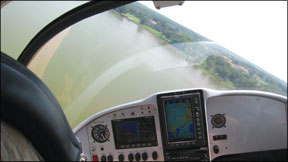
The low fuselage and flip-up canopy makes getting in and out easy. The single, center stick helps with this as there’s nothing under your knees to get in the way. Seats are leather, comfortable and adjust fore and aft with three positions, as we’ll as several recline angles. They must be set before takeoff, however.
We feel there are a few ergonomic challenges to this airplane. Number one is the brakes. They are toe brakes, but the angle is high (due to the curve of the hull) and requires bending your foot far back. Even when company president and demo pilot Carlos Bessa showed us the “punch” technique he uses to apply them, it looked and felt awkward. We adjusted. The plus side is the brakes are hardly needed even though the Seamax has a free-castering nosewheel. Prop thrust over the rudder makes it effective at almost any speed.
The Seamax uses an overhead panel for circuit breakers, most switches, the gear handle and the ignition key. While this has a certain aircraft appeal, we found the reaching back to be awkward and unnecessary given all the space on the panel. You must also look back to see the fuel level in each wing tank, and to turn on and off tanks as needed. This is somewhat of a necessity given the aircraft design, but it’s still not ideal.
The Seamax is light: only 725 pounds empty weight. Because it was first certified as an ultralight in South America and Europe, its gross weight is only 1320 pounds, yet it bests the Searey for useful load. There decent space for 88 pounds of bags or gear behind the seats, and you can reach back there in flight.
The light aircraft, however, may come at a cost in wear. We had the flap switch break and a rudder-center spring pop off during our test flights. That may have just been bad luck, but the throttle handle, gear switch and seat adjustments all had a light-weight feel. To be fair, the majority of LSAs fall into this category (and the fact that the Searey doesn’t may be why it weighs 900 pounds empty). Most Seamax parts come from Aircraft Spruce, so replacement shouldn’t be an issue.
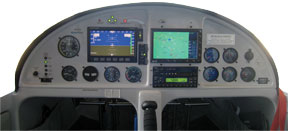
Some nice touches on the Seamax are boat cleats for tying up at docks, a center console for loose items, seat cushions that double as flotation devices and mirrors on each sponson to see the gear. The sponsons are designed to break away if you catch them on something, and the hull has Kevlar reinforcement. There is also a system to route air to the hull step for easier takeoffs from the water. Cabin heat from the Rotax radiator is currently an option, but will be standard next year.
Sensitive and Stable
We enjoyed flying the Seamax, but it took a few moments to settle into the airplane. The controls are quite light—less than 1.5 pounds of stick force for pitch or roll. One of our editors described this as “sensitive”; another one called it “twitchy.” Given that its wing loading is barely 10 lbs/ft2 at gross weight, this isn’t too much of a surprise. We definitely noticed the turbulence as from daytime heating.
Balancing that, however, is that if you simply let go of the controls, the Seamax motors along happy and sedate. In fact, the airplane is surprisingly stable in all axes. Stalls and slow flight were as benign as a primary trainer. This may be largely due to the optional vertical fins on the horizontal tail. The Seamax can be flown with no, two or four of these fins. We had two on the test plane. According to Bessa, this makes a huge difference and the aircraft requires much more rudder skill without them. The Seamax still requires attention to rudder as it has significant adverse yaw, even with two fins. The low thrust-line mitigates much of the pitch changes following power changes. It’s so subtle many pilots would correct without noticing.
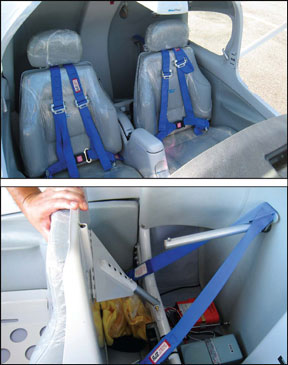
Visibility in flight is fishbowl excellent. You’ll want some slap-on sun visors in hot weather. Ventilation is good for a bubble canopy, with two scoops on the canopy itself, and two more vents behind the pilots in the cabin. Canopy latches are solid, easy to reach and we’ll marked.
The Seamax doesn’t leap off the runway or the water, but it climbed at 500 FPM on a hot day. It’s faster in cruise, doing 95 knots with the flaps in the reflex (negative flap) position at gross weight and high power. It might cross 100 lightly loaded.
The Seamax behaves we’ll on the water, with a slight tendency to porpoise on landing that’s easy to correct. It comes onto the step fairly quickly and is easy to step taxi. The perspective takes some getting used to, as your backside is we’ll below the waterline. The airplane has a large retractable water rudder, which we didn’t need. We believe it could handle strong winds and the one-foot seas the manufacturer claims.
On pavement, the Seamax’s short, stiff gear make it handle more like a twin. Lift the nosewheel slightly and let it fly off. Land with some power in a slightly nose-high attitude. The view over the nose is twin-like as well. You may land crooked until you get the sight picture correct.
The base model Seamax is $137,000. With an airframe parachute, EFIS and mounted GPS, it tips the scales at $146,000. The purchase includes a seaplane rating, presuming you already have at least a Light Sport certificate.
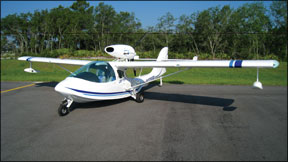
LSA with Benefits
There’s no need to wait for the Icon A5 if you want an amphibious LSA. We see the Searey as a solid, knockabout machine that will go just about anywhere you could want and let you enjoy the scenery on the way. It’ll put up with hamfisted technique but reward your skills as they grow.
The Seamax is tipped more toward comfort and cruising. It’s easier to get in and out of, check the oil or store bags for a trip to far-flung waterways. But it will demand more of your pilot technique and your wallet.
While you can’t have it all, you can have a lot more fun in an LSA if you can get your feet wet.

